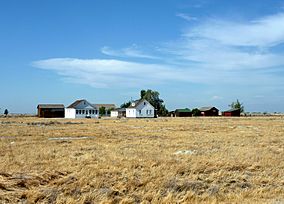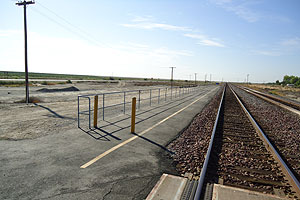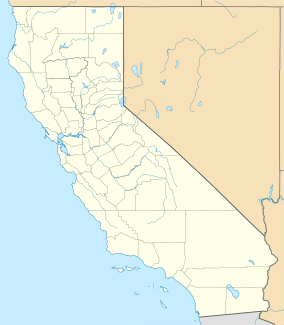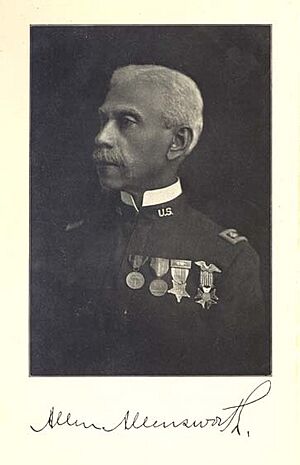Colonel Allensworth State Historic Park facts for kids
Quick facts for kids Colonel Allensworth State Historic Park |
|
|---|---|

The restored buildings in Allensworth rise from the San Joaquin Valley
|
|
| Location | Tulare County, California United States |
| Nearest city | Earlimart, California |
| Area | 3,715 acres (15.03 km2) |
| Established | 1973 |
| Governing body | California Department of Parks and Recreation |
|
Allensworth Historic District
|
|
| Built | 1908 |
| NRHP reference No. | 72000263 |
| Added to NRHP | February 23, 1972 |
| Reference #: | 1047 |
Colonel Allensworth State Historic Park is a special place in California, United States. It protects the historic town of Allensworth. This town was unique because it was the only one in California started, paid for, and run by African Americans.
The small farming town began in 1908. It was founded by Lt. Colonel Allen Allensworth and a few friends. These friends included Professor William Payne, Reverend William Peck, miner John W. Palmer, and real estate agent Harry A. Mitchell. They wanted to create a place where African Americans could improve their lives. Colonel Allensworth was inspired by the Tuskegee Institute and hoped to build a similar community in the West.
Sadly, the town faced big problems, like a drop in its water table. This led to the town's decline. Today, Allensworth is an unincorporated area in Tulare County.
The park even has a train station! It's used for special events or when large groups visit.
Contents
Allensworth: A Town Built on Dreams
Starting a New Life
In 1908, Lt. Colonel Allen Allensworth and his partners had a big dream. They wanted to build a town where African Americans could own land and live the American Dream. They chose a spot in Tulare County, about 45 miles (72 km) north of Bakersfield. This area had good soil, enough water, and was next to a railroad.
Many African American families moved to this new town. They were craftsmen, farmers, business owners, and retired military members. In 1914, a newspaper reported that Allensworth's land was worth over $112,000. The town was run by a group called the Allensworth Progressive Association. Both men and women held important roles in the community.
Daily Life and Businesses
Allensworth's economy was based on farming. Farmers grew crops like alfalfa, wheat, and cotton. They also raised dairy cows, chickens, and turkeys. The town had many businesses and public buildings. These included a bakery, a drugstore, a barbershop, a church, a school, and a library. In 1913, it was said that Allensworth's businesses made almost $5,000 each month.
In 1910, Joshua and Henrietta Singleton opened Singleton's General Store & Post Office. It sold many different items and was a place to weigh wagons. The Allensworth Hotel, run by Clara and John Morris, had eight rooms. A night's stay cost 75 cents.
The Challenge of Water
When Allensworth was founded, there was plenty of water from wells. The town even had water pipes going to homes by 1912. However, water problems started in 1912 and became very serious by 1914. The amount of water underground began to drop. Also, problems with alkali salts in the soil grew worse. These issues made it hard for the town to survive. As people moved away, land values fell, and some homes became empty.
By the 1950s, Allensworth had no safe drinking water. Its wells were contaminated with arsenic. State health officials said the water was unusable. Later, when the state bought the land for the park, they helped former owners move.
Colonel Allensworth's Legacy
Colonel Allensworth died on September 14, 1914. He was hit by a motorcycle after getting off a train. He was on his way to speak at a church. Newspapers reported that he suffered many injuries and passed away after two days.
His death was a huge loss for the community. He was widely loved and respected. He received a military funeral and memorial services were held across the country. Without his strong leadership, the town began to struggle. By 1920, many key figures, including his wife Josephine, had left Allensworth. The number of residents continued to decrease during the Great Depression and World War II.
Allensworth Becomes a State Park
In 1968, Cornelius "Ed" Pope, who once lived in Allensworth, worked for California's Parks Department. He helped create a plan to restore Allensworth as a historical site. In 1972, the "Allensworth Historic District" was added to the National Register of Historic Places.
Finally, in 1974, Governor Ronald Reagan approved the creation of the park. Colonel Allensworth State Historic Park officially opened in 1976. Ed Pope even returned to help preserve the site.
In October 2008, the town celebrated its 100th anniversary. Special events are held throughout the year to remember the park's history.
The park has nine restored buildings, including a school, a hotel, a general store, and homes. There's a visitor center with a video called "The Spirit of Allensworth." You can also arrange tours in advance.
The park offers fifteen campsites for RVs or tents, open all year. Each site has a picnic table and a camp stove. There are also flush toilets and facilities for people with disabilities. A picnic area is shaded by 75 large trees.
The park is about 10 miles (16 km) southwest of Earlimart. It's located on County Road J22, just west of [SR-43].
Images for kids
Nature and Wildlife
The land around Allensworth looks like much of the southern San Joaquin Valley. It's mostly flat, with only small changes in elevation. The valley usually has a warm, dry climate. Summers are hot, and winters are mild. Most rain falls from October to April. Snow is very rare, but winter temperatures can drop below freezing. Summer temperatures often go above 100 °F (38 °C).
Before the 1900s, the valley had seasonal lakes and vernal pools. Today, you might see Burrowing owls in the park. These owls are active during the day.
Just north of Allensworth is the 6,389-acre (2,586 ha) Pixley National Wildlife Refuge. This refuge is home to many animals. Next to the town is the Allensworth Ecological Reserve. The endangered San Joaquin kit fox can be found in this area.
In 2007, a new law was passed to protect the park. It created a 2.5-mile (4.0 km) dairy-free zone around the park. This was to prevent bad smells and flies from dairies from affecting the historic park and nearby wildlife refuges.
Allensworth Train Station
|
Allensworth State Historic Park
|
|||||||||||
|---|---|---|---|---|---|---|---|---|---|---|---|

Allensworth State Park station platform in 2012
|
|||||||||||
| Location | 4011 Grant Drive Allensworth, California United States |
||||||||||
| Coordinates | 35°51′50″N 119°23′08″W / 35.8640°N 119.3856°W | ||||||||||
| Line(s) | BNSF Bakersfield Subdivision | ||||||||||
| Platforms | 1 side platform | ||||||||||
| Tracks | 2 | ||||||||||
| Other information | |||||||||||
| Station code | Amtrak: CNL | ||||||||||
| Services | |||||||||||
|
|||||||||||
The Allensworth station is located near the park's entrance. It's just off the Central Valley Highway (SR-43). The station has a platform but no shelter. Amtrak's San Joaquin service stops here. This train travels between Bakersfield and either Oakland or Sacramento.
This is a special stop. Trains only stop for groups of 20 or more who book in advance. However, public service is offered during special events at the park. These include the annual Juneteenth celebration and the rededication event in October.
In 2024, passengers used the station.
Old Railroad Boxcars
Two rare railroad boxcars from the 1800s are on display at the park. People believe these boxcars were once homes for the station agent in Allensworth. The California State Railroad Museum carefully restored them.
These boxcars are very old and special. Their wheels and axles were removed long ago. Today, they are rare examples of early freight cars. One car was fully documented and preserved to museum standards.










